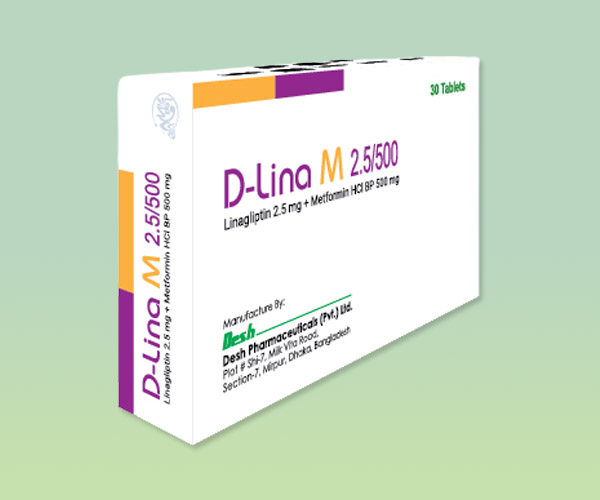D-Lina M 2.5/500 Tablet
Linagliptin + Metformin HCl BP
D-Lina M 2.5/500 Tablet
Linagliptin + Metformin HCl BP
DESCRIPTION
Linagliptin and Metformin combination is used to treat high blood sugar levels caused by type 2 diabetes. Linagliptin helps to control blood sugar levels by increasing substances in the body that make the pancreas release more insulin. It also signals the liver to stop producing sugar (glucose) when there is too much sugar in the blood. Metformin reduces the absorption of sugar from the stomach, reduces the release of stored sugar from the liver, and helps your body use sugar better. This medicine does not help patients who have insulin-dependent or type 1 diabetes.
- AVAILABILITY: AVAILABLE
COMPOSITION
D-Lina M 2.5/500 Tablet: Each film-coated tablet contains Linagliptin INN 2.5 mg & Metformin HCl BP 500 mg.
INDICATION
Indicated as an adjunct to diet and exercise to improve glycemic control in adults with type 2 diabetes mellitus.
DOSAGE AND ADMINISTRATION
D-Lina M 2.5/500 Tablet: The recommended dose of Linagliptin 2.5 mg & Metformin 500 mg twice daily.
D-Lina M 2.5/850 Tablet: The recommended dose of Linagliptin 2.5 mg & Metformin 850 mg twice daily.
Linagliptin & Metformin combination tablets can be taken with or without food. No dose adjustment is required for renal or hepatic impairment.
CONTRAINDICATION
Linagliptin is contraindicated in patients with a history of severe renal impairment, acute or chronic metabolic acidosis, including diabetic ketoacidosis and a hypersensitivity reaction to linagliptin and metformin.
PRECAUTION
Under certain conditions, too much metformin can cause lactic acidosis. The symptoms of lactic acidosis are severe and quick to appear and usually occur when other health problems not related to the medicine are present and are very severe, such as a heart attack or kidney failure. Symptoms of lactic acidosis include abdominal or stomach discomfort, decreased appetite, diarrhoea, fast or shallow breathing, a general feeling of discomfort, muscle pain or cramping, and unusual sleepiness, tiredness, or weakness.
Be sure to drink extra fluids when you exercise or increase your activity or if you have vomiting or diarrhea. Pancreatitis may occur while you are using this medicine. Check with your doctor right away if you have sudden and severe stomach pain, chills, constipation, nausea, vomiting, loss of appetite, a fever, or lightheadedness. Need to temporarily stop taking this medicine before you have major surgery or diagnostic tests including procedures that use contrast dye.
It is very important to carefully follow any instructions from your healthcare team about:
>> Alcohol—Drinking alcohol may cause severe low blood sugar.
>> Other medicines—This especially includes nonprescription medicines such as aspirin, and medicines for appetite control, asthma, colds, cough, hay fever, or sinus problems.
>> Counseling—Other family members need to learn how to prevent side effects or help with side effects if they occur.
>> Travel—Keep a recent prescription and your medical history with you. Make allowances for changing time zones and keep your meal times as close as possible to your usual meal times.
>> In case of emergency—There may be a time when you need emergency help for a problem caused by your diabetes. You need to be prepared for these emergencies. It is a good idea to wear a medical identification (ID) bracelet or neck chain at all times. Also, carry an ID card in your wallet or purse that says you have diabetes and that lists all of your medicines.
Linagliptin and metformin combination can cause hypoglycemia (low blood sugar). However, this can also occur if you delay or miss a meal or snack, drink alcohol, exercise more than usual, cannot eat because of nausea or vomiting, take certain medicines, or take linagliptin and metformin in combination with another type of diabetes medicine. The symptoms of low blood sugar must be treated before they lead to unconsciousness (passing out). Different people feel different symptoms of low blood sugar. It is important that you learn which symptoms of low blood sugar you usually have so you can treat them quickly.
SIDE EFFECT
Linagliptin-The most common side effects of linagliptin are stuffy or runny nose and sore throat. Hypoglycemia may occur when linagliptin is combined with insulin or a sulfonylurea-type drug. Allergic reactions and muscle pain also may occur. Pancreatitis also has been reported. Metformin-The most common adverse reactions due to initiation of metformin are diarrhoea, nausea/vomiting, flatulence, asthenia, indigestion, abdominal discomfort, and headache.
USE IN PREGNANCY AND LACTATION
Pregnancy: Pregnancy Category C.
Nursing mothers: Caution should be exercised when Linagliptin is administered to a nursing woman.
Pediatric patients: The safety and effectiveness of Linagliptin in patients below the age of 18 have not been established.
USE IN GERIATRIC PATIENT
Linagliptin is minimally excreted by the kidney; however, Metformin is substantially excreted by the kidney. Considering that ageing can be associated with reduced renal function, Linagliptin + Metformin combination should be used with caution as age increase.
STORAGE
D-Lina M should be stored between 15°C to 30° C.
PRESENTATION:
D-Lina M 2.5/500 Tablet: Each box contains 3 x 10 tablets in blister pack.
